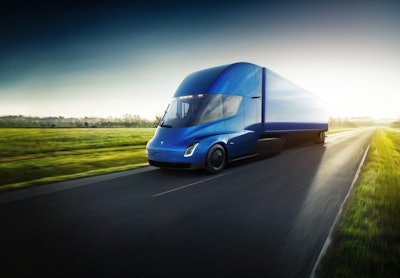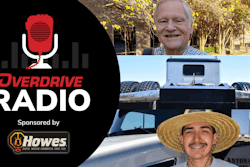
Early last month Tesla CEO Elon Musk said his company would finally kick off deliveries of its oft-delayed all electric Semi. We've heard that claim more than once before, but this time his declaration came with a date – Dec. 1.
We don't know how many Semis Tesla is going to build and deliver this year – hell, Tesla might not even know – but we know where they're going: to PepsiCo. On Tesla's earnings call Oct. 19, Musk said he expects to ramp production to about 50,000 units annually by 2024, which should be enough to put Tesla in the Top 3 for trucking marketshare that year.
I was in Fremont, California, in 2017 when Musk rolled out two prototype Semis. Over the last decade I have been to and sat through scads of new truck announcements. This spectacle was unlike anything I've ever seen before or since; part stunt driving exhibition (Roadster 2 was also unveiled at the same event) and part corporate infomercial (But wait! There's more!).
I started my journalism career in newspapers and covered college football for a while. In the press box at the University of Alabama there used to be a sign that read, "no cheering in the press box." This was pre-Nick Saban and before everyone with a social media channel was considered a "journalist," so there might be more than one sign up there now.

There was some full-on cheering from the press box going on at the Semi debut, and I'm talking "David Lee Roth walking on stage as the intro to Jump begins to play" kind of cheering. I guess that's driven by a changing of the guard in new media and "kids today."
Semi's launch was less about the truck and more about the fanfare. We weren't even allowed inside it. We were, however, able to walk through a cutaway version.
Electric apples and oranges?
Musk claims his Semi has a range of 500 miles, a calculation that is based on an 82,000-pound gross.
A 6X4 eCascadia has a range of about 220 miles with a curb weight of about 22,000 pounds – a figure that's really easy to find on Freightliner's website. We have no idea how much Tesla's Semi weighs.
How does the Semi get more than twice the range at a comparable curb weight? Or does it? I have seen reports, mostly from Tesla fan blogs, that it weighs about 25,000 pounds. A person on Twitter last month told me it weighed 11,000 pounds. I'm still not sure if that was a joke or if he was serious.
The easy answer is that Tesla's battery technology likely enables an extended range, but can it really be 100%-plus better at a mostly similar tare weight with all other factors being equal? That seems a feat of engineering that simply isn't possible.
Musk on the Oct. 19 call emphasized that the 500-mile range comes with "no sacrifice to cargo capacity." He didn't expound on that but I think it's clear that he means fleets can get upwards of 500 miles at its typical payload; or at least his truck will haul the same payload as the eCascadia and, allegedly, twice as far. But how? I emailed Tesla's generic press address multiple questions twice in the last two and a half weeks and never heard back.
Once they are commercially available, Tesla's 4680 battery cells are expected to add 16% in range compared to current generation cells, but Musk said Oct. 19 that 4680 cells won't be used in Semi – at least in the first deliveries – so those don't factor into the range claim.
The Mercedes Benz EQB battery-electric crossover SUV gets up to 250 miles of all electric range. A Tesla Model Y, a vehicle that would be considered a competitor to the EQB, gets up to 330 miles per charge. The curb weight of the Model Y and EQB are pretty close – a less than 200 pound difference, with the Model Y being lighter. The Tesla gets about 32% more range in a passenger car setting than its Daimler competitor yet, in a commercial vehicle, the all-electric range delta jumps to 130%?
How much of this is enabled by the use of unconventional (or light-weighted) parts or components in the Semi? For example, a production tractor with a carbon fiber cab or aluminum rails. Is the trailer used for the weight calculation a standard off-the-lot dry van trailer, or is it aggressively light-weighted? Trucking has had mixed results with the reliability of light weight components, and there's not a lot of carbon fiber trailers to be had, not to mention how expensive (and impractical) that would be, driving any TCO savings completely out of bounds.
So what do we know? Well, we have a benchmarks.
According to the North American Council for Freight Efficiency, the average weight of the eCascadia, Kenworth T680e, Volvo VNR Electric, Peterbilt 579EV, BYD 8TT and Nikola TRE electrics is about 24,200 pounds. The average maximum mileage range is about 220 miles. Clearly, something about Tesla is different than all the others. In every analytical scenario, the Semi is an outlier.
You got the right one baby
Pepsi was one of the early orders on the books for Tesla's Semi but why would the first trucks – ones equipped with a 500 mile range – go to a private fleet that doesn't need that kind of daily range and weight when there are (or were) fleets on the order book that do?
I think the answer is simple: marketing.
The fact that Tesla doesn't pay for advertising is one of Musk's go-to claims and, according to Statista and PepsiCo's financials, PepsiCo spends more than $3 billion annually on advertising and promotion. It's also one of the premier sponsors of one of sports' crown jewels: the Super Bowl.
PepsiCo is one of the companies at the forefront of green transportation. It has committed more time, energy, effort and dollars to slashing its carbon footprint than just about anyone else, and they absolutely should promote their efforts to consumers. Hitching its wagon to Elon Musk is surely to be quite a ride.
Pepsi really started to eat into Coca-Cola's imposing marketshare when it went all-in on the "new generation," a star-studded campaign spearheaded by Michael Jackson, the single biggest celebrity on the planet at the time. Van Halen helped launch Crystal Pepsi during Super Bowl XXVII.
Celebrities don't move the needle like they used to, but Elon Musk, with Tesla's legion of fans in tow, will not only move the needle, he might snap it off.
The new "new generation" is more interested in social consciousness than what soda the late King of Pop drank. Green energy is the new Crystal Pepsi and Elon Musk the is Michael Jackson in that space.
Pepsi was an underdog in the cola wars of the 1980s, and Musk is a master of painting his company as an "us versus them" crusader against the internal combustion engine. In Elon Musk, Pepsi gets the EV King and one of social media's and new media's brightest stars. In Pepsi, Elon Musk gets something he desperately needs in commercial trucking: street cred. It's an alignment that makes sense for both parties.
I'm skeptical of Tesla's heavy truck viability, especially now that the likes of Mack, Volvo, Freightliner, Peterbilt, Kenworth and International all have a head start. Had Semi debuted in 2019 as originally intended, I think there was an opportunity for Tesla here. But my skepticism shouldn't be confused with pessimism. I'm not cheering from the press box in favor of one (or any) of trucking's legacy OEMs versus Tesla. Tesla can help drive some important innovations in electric trucking, but only if the goal is to deploy practical units that solve practical and real world trucking problems.










